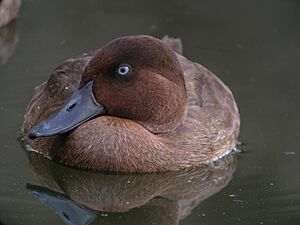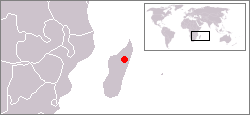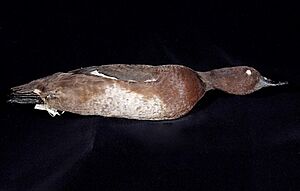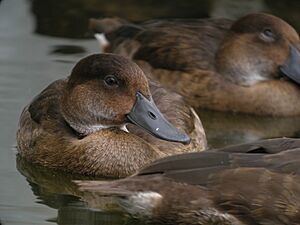Madagascar pochard facts for kids
Quick facts for kids Madagascar pochard |
|
|---|---|
 |
|
| Male Madagascar pochard, captive breeding program, Madagascar | |
 |
|
| Female Madagascar pochard, captive breeding program, Madagascar | |
| Conservation status | |
| Scientific classification | |
| Genus: |
Aythya
|
| Species: |
innotata
|
 |
|
| Former range (in red) | |
| Synonyms | |
|
Nyroca innotata Salvadori, 1894 (basionym) |
|
The Madagascar pochard (Aythya innotata) is a very rare diving duck. It is also known as the Madagascan pochard. For a while, people thought this duck was extinct. But in 2006, some of these ducks were found again! They were discovered at Lake Matsaborimena in Madagascar.
By 2017, a special program had helped grow their numbers. There were about 90 Madagascar pochards in this program. In December 2018, some of these birds were set free into the wild.
Unlike other diving ducks, the Madagascar pochard mostly eats water insects. Baby ducks, called ducklings, start diving for food when they are about 14 days old. Before that, they find their food on the water's surface.
Contents
Discovering the Madagascar Pochard
Scientists did not pay much attention to the Madagascar pochard in the 1800s. Many thought they were seeing a different duck, the ferruginous duck. Even after the Madagascar pochard was officially described in 1894, it was still largely ignored.
It is hard to know how many of these ducks existed back then. But reports from the 1920s and 1930s suggest the bird was quite common. It lived around Lake Alaotra in Madagascar.
The Madagascar pochard is the only duck of its kind. This means it does not have any different types or subspecies. It is thought to be related to other ducks like the Hardhead and Baer's pochard.
What Does the Madagascar Pochard Look Like?
The Madagascar pochard is a medium-sized duck. It is about 42 to 56 centimeters long.
Young ducklings have brown eyes. Their feathers are a pale, dull brown or chestnut color. Their stomachs are a bit darker.
Adult ducks are darker in color. Male ducks get white eyes during their first winter. Breeding males have dark chestnut heads, chins, and necks. Their chests are also dark chestnut. The top part of their bodies is blackish-brown. Their wings are dark brown with a white stripe. The feathers under their bodies, from the stomach to the tail, are white. The undersides of their wings are also white. Their beaks and legs are dark grey with black nails.
When male ducks are showing off, they might make a sound like a cat's "wee-oow." They also make a rolling "rrr" sound. Female ducks make a harsh "squak."
Where Do They Live?
The Madagascar pochard lives only in wetlands on the island of Madagascar. This means it is an endemic animal there. Today, you can only find wild populations at Lake Sofia and Lake Matsaborimena.
In the past, these ducks liked shallow lakes and marshes. They preferred places with lots of plants. However, the ducks found in 2006 were in a different kind of place. It was a cold, deep crater lake. This lake had few water plants. It was also surrounded by thick forests. Other deep crater lakes might not be good homes for them. This is because the ducks need shallower water to find food.
Their old home in the Lake Alaotra area was changed by humans. People started growing rice there. Also, new types of fish were brought in. These changes made it hard for the ducks to live there.
How Do They Behave?
Madagascar pochards do not travel to different places for seasons. They usually stay in one area. They also do not typically form large groups. You will often find them in pairs or alone.
Diet and Feeding
The Madagascar pochard spends about 38% of its day looking for food. Their diet is mostly made up of water insects. One study looked at their droppings. It found that caddisflies were the most common insect they ate. After that came dragonfly larvae, bugs, and flies.
These ducks dive underwater to find most of their food. They usually stay underwater for about 24 seconds. Ducklings eat food from the surface of the water. They start diving when they are about 14 days old. When they first start diving, their dives are shorter, around 10 seconds.
Reproduction
People have seen these ducks building nests from July to February. Sometimes, they try to nest more than once. Nests are built about 20–40 centimeters above the water. They are found in plants along the edges of lakes or marshes. Each nest usually has 6 to 10 eggs.
Why the Ducks Almost Disappeared
The number of Madagascar pochards likely dropped a lot in the late 1940s or early 1950s. This happened because new types of fish were put into the lakes. These fish ate most of the baby pochard chicks. They also damaged the places where the ducks nested. Adult ducks might have also been harmed by these new fish.
Other things also caused the ducks to disappear from the lakes. These include growing rice, cows eating plants on the shores, and burning plants. Rats that were brought to the island also caused problems. Fishing with nets and hunting also played a part.
The last time many of these birds were seen at Lake Alaotra was on June 9, 1960. A small group of about 20 birds was spotted. Even though the duck was very rare in 1960, a male duck was shot. This duck is now kept at the Naturalis Biodiversity Center. There was also a report of a sighting near Antananarivo in 1970, but it is not certain.
Rediscovery and Reintroduction
Before 2006, the last confirmed sighting was in 1991. That single male duck was caught and kept in a garden in Antananarivo. It died a year later. People searched for more of these birds in 1989–1990, 1993–1994, and 2000–2001. But they did not find any.
Then, in November 2006, a group of nine adult ducks and four ducklings was found! They were at Lake Matsaborimena, in a far-off part of northern Madagascar. This lake was "too deep and too cold for the pochards to thrive." But it was one of the few wetlands left that could support the ducks. Other wetlands were damaged by pollution, invasive species, and farming.
Because of the rediscovery, the duck's status was changed. In 2006, it was listed as "Possibly Extinct." But in 2007, it was changed back to "Critically Endangered." This means it is still in great danger of disappearing forever. By 2008, only 25 adult birds were counted in the wild.
Conservation Efforts
In 2009, a rescue plan began. Groups like the Durrell Wildlife Conservation Trust and the Wildfowl & Wetlands Trust took eggs from a nest. They hatched them in a lab set up in a tent by the lake. The day-old chicks were then taken to a safe place in a local hotel. By the end of 2009, these groups had collected 24 eggs. From these, 23 ducklings hatched.
These ducklings were raised in a special breeding center. In April 2012, eighteen more ducklings hatched there. This brought the total number of ducks to 60. In 2011, the first chick hatched from these captive breeding efforts. By April 2013, the population reached 80 ducks.
In autumn 2017, the population grew to 90 ducks. This meant it was time to put some of them back into the wild. The conservation groups prepared a suitable lake, Lake Sofia, for the reintroduction. They also worked with the communities living around the lake. In December 2018, 21 of the ducks were released at Lake Sofia. Special floating aviaries were put in place to protect the birds.
See also
- Endemic birds of Madagascar and western Indian Ocean islands





